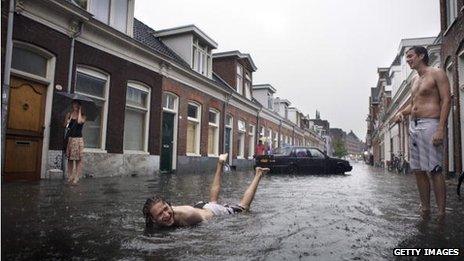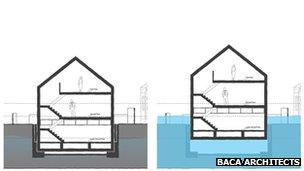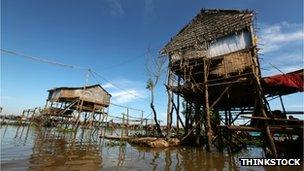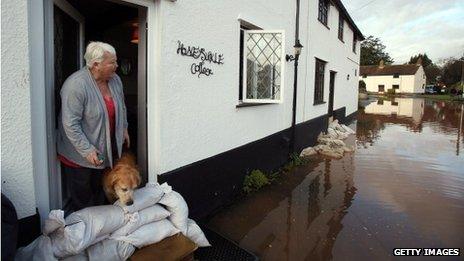Are floating homes a solution to UK floods?
- Published

A floating house in Colombia, modelled on a Dutch design
The recent flooding across the UK has seen hundreds of householders desperately trying to prevent water from entering their houses.
Most use the centuries-old approach of piling heavy sandbags at their doors and windows.
But what if your house was buoyant - rising at the same level as the surrounding water?
Earlier this year, Baca Architects was granted permission to build Britain's first amphibious house by the banks of the River Thames in Buckinghamshire - one that rests on land, but in the event of a flood rises with the water.
The Environment Agency is interested in the idea of such floating homes, says the agency's flood risk engineer Tony Andryszewski who often works at a flood test centre, set up to investigate new technologies for flood prevention and control.
The agency is keen on seeing how other countries approach the problem, he says, especially in the Netherlands.
The Dutch are widely acknowledged as having the best flood management technologies in the world.

Floating houses in British Columbia, Canada, are designed differently from the ones in Holland
Even the flood forecasting software used by the Environment Agency, Delft-FEWS, has been developed by the Dutch.
Flood-proofing
Such know-how is not surprising - much of the Netherlands' land mass is below sea level, and even the country's name reflects its low-lying topography,
Since the 12th Century people have been draining delta swamps and creating artificial dry land - polders - at first using pumps powered by windmills.
Currently, there are about 3,500 low-lying polders enclosed by dykes in the Netherlands. They easily collect water from rain, rivers and the sea, and are constantly being pumped to keep nearby communities dry.
"The Dutch have built dykes for over 1,000 years," says Jos Maccabiani from Flood Control 2015, a Dutch government programme charged with developing better information systems for managing floods.
"Since the last major flood in 1953, in which more than 1,800 people died, this system has been upgraded to very high standards."
According to computer simulations, today's defences in the Netherlands are supposed to withstand the kind of flood so severe that it would occur only once in 10,000 years, he explains.
There are dams all around the country, guarding all main river estuaries and sea inlets.

Many Dutch live below sea level so flood management technology is vital
"Nevertheless, with the ever-increasing urbanisation of our polders and flood plains, spatial planning is increasingly combined with flood resilience," adds Mr Maccabiani.
"There are projects under way where urban revitalisation of a city is combined with the widening of the river bed, lowering the peak water levels, and others that look into flood-proofing the country's highway infrastructure."
Ready to float?
One Dutch technology that the UK is observing keenly is the "smart levee", designed in the Netherlands as part of an EU research project, UrbanFlood.

An amphibious house rises with the water level - and sinks to its original position when the flood subsides
Sensors are put inside flood embankments, as an early online warning system and for real-time emergency management. The technology constantly monitors the condition of the levee, and sends a warning when it is weakening.
Another innovation that Britain has already started to adopt is movable river barriers - installed in the ground, they rise with the water.
Dutch floating houses are also on the Environment Agency's radar, says Mr Andryszewski.
Homes on stilts are common in flood-prone countries such as Thailand, Burma and India. Floating houses of different designs exist in a few places too, namely in Germany, Canada, the US, and even on Taggs Island in the UK, where some 60 homes are attached to piles driven into the riverbed of the Thames.
But creating an amphibious home - placing a house on a platform that makes the house float in case of a flood - has only recently been looked at in the Netherlands.
In 2005, Dutch firm Dura Vermeer built several buoyant houses in the village of Maasbommel, along the Maas River, about 60 miles (100km) from Amsterdam.

Houses on stilts have existed for centuries in flood-prone areas - like this one at Inle Lake, Burma
They rise as the water rises, keeping occupants and their possessions dry. When the floods subside, the houses sink to their original position.
The houses float on hollow pontoons made of concrete and timber. All pipes and ducts for water, gas, electricity, and sewage disposal are flexible and keep functioning even when a house rises several metres.
Unlike boats, the houses can't drift away, as they are kept in place by sturdy posts set deep into the ground.
Currently, Dutch architectural company Waterstudio is planning to build an entire apartment complex on water, which it says could accommodate hundreds of people.
'Sandless' sandbags
Even if the UK doesn't build floating houses any time soon, there are some innovations that could at least replace the heavy sandbags.
UK entrepreneur Richard Bailey designed lightweight bags that expand on contact with water - and also absorb it.
"It was first designed for the Ministry of Defence," says Mr Bailey, explaining that his company FloodSax was asked to create an easily portable alternative to sandbags for the army's bomb disposal unit.

Traditional heavy sandbags are still common, despite existing alternatives
"We put the bag into a barrage unit, the water comes in, gets soaked into the bag, the bag expands, blocking the water at the door.
"Or unfortunately when someone has been flooded, you can put it down in the house, soak up the water and the mud as well, so that you can get back into your house a little quicker."
There are other firms offering similar technology, such as Thailand-based Nanotec or another UK company, HydroSack, and FloodSax's bags are now being used in many countries across the world.
"Unfortunately though, they are still not as popular as the traditional sandbags, because not everyone is aware of the innovation," says Mr Bailey.
But Mr Andryszewski is confident that the UK will continue to use more and more innovative technology - there are already numerous places that use watertight submarine-type doors, he says, and the flood test centre is busy experimenting with other original approaches to keep the land - and homes - as dry as possible.
- Published26 November 2012
- Published26 November 2012
- Published25 November 2012